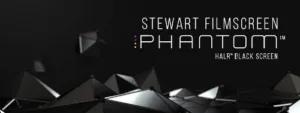The black screens from Screen Innovations have been very successful in the market, but there are limitations. According to Mark Robinson, VP of Technology at Stewart Filmscreen, those limitations included a maximum height of 60” (1.5M), rigid construction, so not rollable, and the inability to make a perforated screen for thru-screen audio.
“We could have come to market sooner with a black screen solution, but we wanted to solve these limitations first,” explained Robinson. “These have been successfully addressed in the new black Phantom light rejecting screen material.”
The new material is fabricated on a flexible substrate so it is rollable and can be perforated. Plus, it is fabricated on very large machines with the maximum size of 40’ x 90’ (12M x 27.5M). “While the SI Black Diamond screen can be tiled, the seams are always visible and we wanted to avoid that,” continued Robinson. “This screen size capability should satisfy all the needs of the custom install market without tiling.”
In terms of the technology of the screen, Robinson said the first layer is a reflective one that directs projected light back into the desired viewing cone. The screen is designed to be unity gain offering wide viewing angles and light efficiency. This is followed by a black layer coating that absorbs more light in angle outside of the central viewing than inside of it. The coating is designed for long throw, head on configurations of the projector and screen. The third layer is a diffuser to spread the light out horizontally.
Overall, Robinson says that 75% of the incident light is returned to the viewer while rejecting a lot of the off-angle light. Stewarts’s Cinemaperf or Microperf X2 THX Ultra configurations for acoustic transparency can be applied to the material.
This was demonstrated in the Stewart booth using a 13’ (4M) wide screen lit up with a 4K Barco Prometheus II projector outputting about 16K lumens. The measured on-screen result was a peak white luminance of 180 fL (52 cd/m²) and a black level of 2 fL (0.6 cd/m²) resulting in a contrast ratio of 90:1, which is incredibly high for a front projection solution. Contrast falls off a bit at the edges, as would be expected, however.
For a more typical home theater configuration, Stewart also says the screen delivers over 30:1 contrast for a 2000 lumen projector in a room with 20 foot-candles of ambient light and several light sources hitting the screen surface at 40-degree angles.
Robinson also noted that there is essentially no color shift in the screen material (just a very slight yellow shift, but no a* or b* deviations). These screens will calibrate well to projectors able to show the DCI-P3 or even laser-based BT.2020 color gamuts. And, since all Stewart Filmscreen materials are spray coated, they have very high spatial resolution – 16K they figure (or 6 lp/mm).
Neutral in both horizontal and vertical direction thanks to the proprietary multi-layer composition, Phantom HALR has no directional limitation. As a result it has no “sweet spot axis,” meaning, Stewart claims, every seat in the house is the best, whether one is sitting directly in front of the screen or off-center.
Stewart Filmscreen makes a wide variety of screens for theatrical, professional and the custom install market. For the latter, most screen sizes are in the 11-14’ (3.5M – 4.25M) range, but they can provide up to 25’ (7.5M) wide screens if needed. The Phantom material is about 15% more expensive than other Stewart materials, concluded Robinson. – CC

